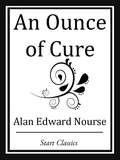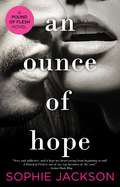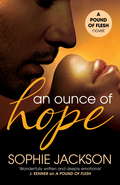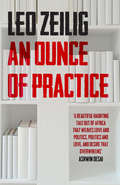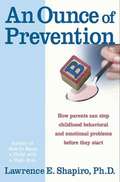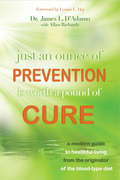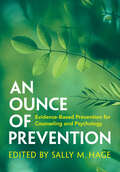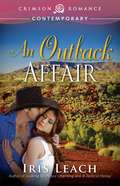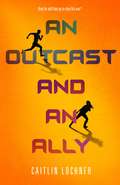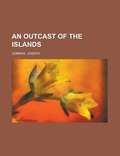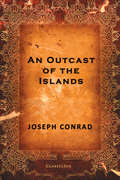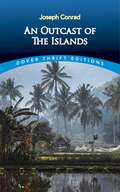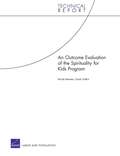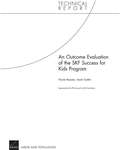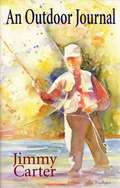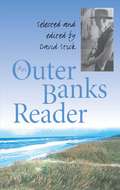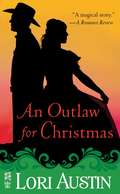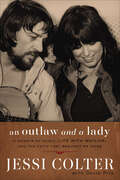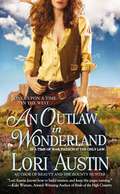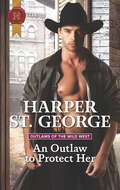- Table View
- List View
An Ounce of Cure
by Alan Edward NourseThis etext was produced from The Counterfeit Man - More Science Fiction Stories by Alan E. Nourse published in 1963.
An Ounce of Hope: A Pound Of Flesh Book 2 (ebook) (A Pound of Flesh #3)
by Sophie JacksonFrom the fanfic phenom whose debut A Pound of Flesh had over 4.5 million reads, this sequel, An Ounce of Hope, tells the passionate love story of Carter's best friend, Max.Max O'Hare can't seem to let go of his past: his drug habit, the end of his relationship with Lizzie Jordan, the woman he knows he'll never get over, and the loss of their unborn son. After successfully completing rehab and learning to explore his deepest fears and dreams through painting, Max meets Grace Brooks. With her innate optimism, and her love of art and photography, Grace appears to be the perfect girl. Yet no one knows where she came from, or why she keeps her past so closely guarded. Over time, Max and Grace gradually allow each other in--but will he ever be able to fully let go of his past? Or will his heart remain closed forever?
An Ounce of Hope: A powerful, addictive love story (A Pound of Flesh)
by Sophie JacksonAn Ounce of Hope is the third title in the A Pound of Flesh series from fan-fiction superstar Sophie Jackson.From the fanfic phenomenon whose sensational debut, A Pound of Flesh, had over 4.5 million reads. You fell for Wes Carter. Now there's a new bad boy in town. Just as sexy, just as edgy. Meet Carter's best friend, Max...Fans of Samantha Young, Jodi Ellen Malpas, Jamie McGuire, Katy Evans and Prison Break will find Sophie Jackson's powerful love stories utterly addictive and unforgettable. Can true love heal the deepest scars?Max O'Hare: Tortured by memories of the woman he loved, the child he lost and the drugs that numbed his pain, Max is haunted by his past.Grace Brooks: An eternal optimist, Grace appears to be the perfect girl, but she keeps the truth of her own difficult history closely guarded.Fresh out of rehab, the last thing on Max's mind is a relationship. Yet he's drawn to Grace, sensing that she too is looking for escape. Bound by their greatest fears and deepest secrets, Max and Grace must learn to trust again. And the key to opening their hearts lies in one another...Loyalty. Redemption. All-consuming love against the odds. Prepare to fall for the powerful storytelling of Sophie Jackson. Check out the whole A Pound of Flesh series: A Pound of Flesh, Love and Always, An Ounce of Hope, Fate and Forever and A Measure of Love.
An Ounce of Practice
by Leo ZeiligAn impressive and immersive novel told against the backdrop of the Arab Spring. Set between London and Harare in the present day, the novel follows a group of quasi-revolutionaries who are fighting against Mugabe's dictatorship and in favor of Socialist policies. It is a novel about hope, fear, and failure, and how fighting for an all-consuming cause can forge some relationships but ruin others. As Viktor's marriage crumbles in London he struggles to make sense of the world around him. He is consumed with ideas about how to bring about radical social change. He befriends Tendai, a Zimbabwean cleaner at his university, and joins his struggle for cleaner's living wage. They share revolutionary ideas, spurring each on, and Tendai suggests that Viktor make contact with his friend in Zimbabwe, Anne-Marie. Through her we are introduced to Nelson, Biko, Lenin, and other figures named after prominent past revolutionaries. Viktor and Anne-Marie start speaking on Skype, and they soon begin to depend on their companionship and their friendship becomes sexual in nature, despite never having met. Urged on by Tendai, Victor decides to travel to Harare to witness the realities of political struggle—following Frantz Fanon's idea about "an ounce of practice." He and Anne-Marie quickly consummate their relationship. Victor becomes caught up with a group of men and women involved in an unusual opposition group with devastating, unexpected results.
An Ounce of Prevention
by Lawrence E. ShapiroMost parents understand the importance of prevention when it comes to the physical health and safety of their children. But what many parents don't realize is that it is also possible to use preventive measures for emotional and behavorial problems. As child psychologist Dr. Lawrence E. Shapiro explains in this provacative new book, parents tend to start paying attention only after actual symptoms begin to develop. Yet many problems can be addressed long before symptoms appear-if parents know just what to look for. Preventing emotional problems is much easier than treating them after they have already become disruptive to a child's life. In An Ounce of Prevention, Dr.Shapiro presents a variety of imaginative, highly successful strategies for handling the pivotal moments in every child's emotional developmentm, from the infant and toddler years through the grad school and teenage years. He helps you understand whether your child is at risk for specific problems and what you can do to reduce the risk. Dr.Shapiro offers advice for parents on such subjects as depression, underachievement, shyness, eating disorders, fallout from divorce, ADHD, and much more. Some of the suggestions will seem like common sense. Teaching your child good eating habits from a very young age will prevent eating disorders in adolescence. Helping a shy child make a phone call to a new friend will prevent social alienation in the teen years. But other recommendations may be surprising. Fearful babies should not be coddled if they outgrow their hypersensitivity. Toddlers should not be overly praised if you want them to as strive for success later in childhood. Parents should become more involved in their teenagers' education even when their teens are pulling away. Filled with wonderful examples and lots of concrete advice, this book presents all the skills you need to hlep your child become more resilient when confronted with many problems that face today's children and teens. Provide "an ounce of prevention" every day. It will make a difference in your child's happines-and yours.
An Ounce of Prevention-Is Worth a Pound of Cure: A Modern Guide To Healthful Living From The Originator Of The Blood-type Diet
by James L. DAdamoWritten in the infancy of America's modern natural-healing movement, his first book, One Man's Food . . . is someone else's poison, detailed his unique, individual treatment method that correlated a person's type of blood with diet, exercise, and spiritual practice. Just An Ounce of Prevention . . . Is Worth a Pound of Cure comes almost 30 years later, as people around the world have increasingly awakened to the efficacy of natural remedies . . . and at a time when the American health-care system is increasingly failing the public. In this fascinating book, Dr. D'Adamo exhorts us to take responsibility for our own health and prevent chronic degenerative diseases using his newest discoveries, which has given him the opportunity to treat more than 50,000 patients. He explains which foods and exercises are right for each of us, what assets and liabilities we're born with, and how our minds can work to better process information. This book contains Dr. D'Adamo's most up-to-date and comprehensive teachings; and includes recipes, exercise regimens, and a panoply of natural therapies he recommends to the patients at his institute. Just An Ounce of Prevention is the consummate statement on natural healing from this generation's most original naturopath. As Dr. D'Adamo writes: "We are all here for a purpose, and we can only aspire to our physical and spiritual fulfillment when the body is healthy and the mind clear. Blood types are a Truth of Nature and, if followed, will provide a person with the physical and spiritual health that Nature has intended for them."
An Ounce of Prevention: Evidence-Based Prevention for Counseling and Psychology
by Sally M. HageThe boundaries of psychology are expanding as growing numbers of psychological scientists, educators, and clinicians take a preventive approach to social and mental health challenges. Offering a broad introduction to prevention in psychology, this book provides readers with the tools, resources, and knowledge to develop and implement evidence-based prevention programs. Each chapter features key points, a list of helpful resources for creating successful intervention programs, and culturally informed case examples from across the lifespan, including childhood, school, college, family, adult, and community settings. An important resource for students, researchers, and practitioners in counseling, clinical, health, and educational psychology, social justice and diversity, social work, and public health.
An Out-of-This-World Vacation (Fountas & Pinnell LLI Gold #Level N)
by Henry HobbsonAn Out-of-This-World Vacation Author: Henry Hobbson
An Outback Affair
by Iris LeachCassie will fight to the end to keep Sam, the nephew she has raised since her sister Claudia was killed in an automobile accident. Sam's uncle, Joel Caine, has other ideas. He wants to share Sam. Trouble is, Joel lives on an outback station in the heart of Western Australia, nearly 2,000 miles from Victoria where Cassie and Sam live.Cassie is adamant that she can't be parted for six months from four-year-old Sam. Joel stands firm. He wants Sam and he'll have him. Sam is heir to a fortune, and there is Joel's sick mother to consider. How can Cassie refuse Sam his father's family?They come to an agreement. She will come with Sam for a few weeks on the horse station. Get him used to the idea of spending half the year with his uncle in the outback and the other half with his aunt in Melbourne. Trouble is, she's scared that once Joel has Sam on the station, he won't let Sam go. And how can Cassie fight Joel on his territory where he's lord and master of his domain?And another thing, how can she fight her growing attraction she feels for the tall and totally hot Joel Caine?Cassie's life is turned upside-down and the question is, will she ever be able to right it again?Sensuality Level: Behind Closed Doors
An Outback Affair
by Iris LeachCassie will fight to the end to keep Sam, the nephew she has raised since her sister Claudia was killed in an automobile accident. Sam's uncle, Joel Caine, has other ideas. He wants to share Sam. Trouble is, Joel lives on an outback station in the heart of Western Australia, nearly 2,000 miles from Victoria where Cassie and Sam live.Cassie is adamant that she can't be parted for six months from four-year-old Sam. Joel stands firm. He wants Sam and he'll have him. Sam is heir to a fortune, and there is Joel's sick mother to consider. How can Cassie refuse Sam his father's family?They come to an agreement. She will come with Sam for a few weeks on the horse station. Get him used to the idea of spending half the year with his uncle in the outback and the other half with his aunt in Melbourne. Trouble is, she's scared that once Joel has Sam on the station, he won't let Sam go. And how can Cassie fight Joel on his territory where he's lord and master of his domain?And another thing, how can she fight her growing attraction she feels for the tall and totally hot Joel Caine?Cassie's life is turned upside-down and the question is, will she ever be able to right it again?Sensuality Level: Behind Closed Doors
An Outback Affair
by Iris LeachCassie will fight to the end to keep Sam, the nephew she has raised since her sister Claudia was killed in an automobile accident. Sam’s uncle, Joel Caine, has other ideas. He wants to share Sam. Trouble is, Joel lives on an outback station in the heart of Western Australia, nearly 2,000 miles from Victoria where Cassie and Sam live.Cassie is adamant that she can’t be parted for six months from four-year-old Sam. Joel stands firm. He wants Sam and he’ll have him. Sam is heir to a fortune, and there is Joel’s sick mother to consider. How can Cassie refuse Sam his father’s family?They come to an agreement. She will come with Sam for a few weeks on the horse station. Get him used to the idea of spending half the year with his uncle in the outback and the other half with his aunt in Melbourne. Trouble is, she’s scared that once Joel has Sam on the station, he won’t let Sam go. And how can Cassie fight Joel on his territory where he’s lord and master of his domain?And another thing, how can she fight her growing attraction she feels for the tall and totally hot Joel Caine?Cassie’s life is turned upside-down and the question is, will she ever be able to right it again?Sensuality Level: Behind Closed Doors
An Outback Affair
by Iris LeachCassie will fight to the end to keep Sam, the nephew she has raised since her sister Claudia was killed in an automobile accident. Sam’s uncle, Joel Caine, has other ideas. He wants to share Sam. Trouble is, Joel lives on an outback station in the heart of Western Australia, nearly 2,000 miles from Victoria where Cassie and Sam live.Cassie is adamant that she can’t be parted for six months from four-year-old Sam. Joel stands firm. He wants Sam and he’ll have him. Sam is heir to a fortune, and there is Joel’s sick mother to consider. How can Cassie refuse Sam his father’s family?They come to an agreement. She will come with Sam for a few weeks on the horse station. Get him used to the idea of spending half the year with his uncle in the outback and the other half with his aunt in Melbourne. Trouble is, she’s scared that once Joel has Sam on the station, he won’t let Sam go. And how can Cassie fight Joel on his territory where he’s lord and master of his domain?And another thing, how can she fight her growing attraction she feels for the tall and totally hot Joel Caine?Cassie’s life is turned upside-down and the question is, will she ever be able to right it again?Sensuality Level: Behind Closed Doors
An Outcast and an Ally (A Soldier and a Liar Series #2)
by Caitlin LochnerDark secrets and conflicting loyalties abound as four superpowered teens are torn apart by war in Caitlin Lochner's An Outcast and an Ally, the epic YA sequel to A Soldier and a Liar.Lai, Jay, Al, and Erik are on the run after the military accuses them of being traitors. Tensions between everyone are high, but they have to stick together if they want to survive. And somehow stop the war that’s now in full swing.But when Erik returns to the rebels to find answers about his past, Lai, Al, and Jay have no choice but to go to the Order—a peace coalition bent on stopping the rebels and dissolving the enmity between gifted and ungifted. However, the longer the war drags on, the more Lai’s long-kept secrets threaten to destroy everything she’s ever worked for. Sparks fly as the team constantly questions whether they can trust one another and everyone tries to navigate a war that will change everything.Filled with the same high-stakes superpowered action and complex relationships as A Soldier and A Liar, Caitlin's first book, An Outcast and an Ally brings this story to a dramatic and satisfying close.Praise for A Soldier and a Liar:"Fans of the Shatter Me and The Darkest Minds series will salivate for A Soldier and a Liar . . . Utterly imaginative and vivid." —Booked J"An interesting mix of supernatural and dystopian, with lots of action and secrets to keep the reader turning the pages for more." —Smada's Book Smack
An Outcast of the Islands
by Joseph ConradAn Outcast of the Islands is the second novel by Joseph Conrad, published in 1896, inspired by Conrad's experience as mate of a steamer, the Vidar. <P> <P> The novel details the undoing of Peter Willems, a disreputable, immoral man who, on the run from a scandal in Makassar, finds refuge in a hidden native village, only to betray his benefactors over lust for the tribal chief's daughter. The story features Conrad's recurring character Tom Lingard, who also appears in Almayer's Folly (1895) and The Rescue (1920), in addition to sharing other characters with those novels. It is considered to be underrated as a work of literature for many. Conrad romanticizes the jungle environment and its inhabitants in a similar style to his "Heart of Darkness".
An Outcast of the Islands (Collected Works Of Joseph Conrad)
by Joseph ConradBy all accounts a man of little virtue, Peter Willems is on the run from a scandal of his own making. But when the assistance of his benefactor, Tom Lingard, secures Willems yet another posting, it isn't long before the immoral Willems takes advantage of his new appointment.Be it mystery, romance, drama, comedy, politics, or history, great literature stands the test of time. ClassicJoe proudly brings literary classics to today's digital readers, connecting those who love to read with authors whose work continues to get people talking. Look for other fiction and non-fiction classics from ClassicJoe.
An Outcast of the Islands (Collected Works Of Joseph Conrad)
by Joseph ConradPeter Willems is down on his luck. The Dutch clerk has been fired for embezzlement from his job in the Indonesian port city of Makassar, and his scornful wife has abandoned him. Willems' despair lifts after an encounter with Tom Lingard, a sea captain who operates a remote trading post. Lingard hires the drifter to act as his agent, entrusting Willems with knowledge of the secret route across dangerous waters to the post. Once installed in his new position, however, Willems falls in love with the daughter of a tribal chief and is drawn into an act of betrayal that will have deadly consequences.Rich in evocative details, Joseph Conrad's second novel offers a cynical view of colonialism in 19th century Indonesia. The atmospheric tale of greed and lust forms the middle volume of a trilogy that began with Almayer's Folly and concluded in The Rescue, illustrating many of the themes the author explored in his later works.
An Outcome Evaluation of the Spirituality for Kids Program
by Sarah J. Gaillot Nicole MaestasThis report presents results from a multisite, quantitative evaluation of the international Spirituality for Kids (SFK) after-school program. A nonreligious program, SFK seeks to build resilience in children. Interestingly, the authors found that the program positively affected not just social and internal outcomes but also school-related outcomes, even though SFK is not an academic intervention.
An Outcome Evaluation of the Success for Kids Program
by Sarah J. Gaillot Nicole MaestasThis report presents results from a multisite, quantitative evaluation of the international Success for Kids (SFK) after-school program. A nonreligious program, SFK seeks to build resilience in children. Interestingly, the authors found that the program positively affected not just social and internal outcomes but also school-related outcomes, even though SFK is not an academic intervention.
An Outdoor Journal: Adventures and Reflections
by Jimmy CarterFormer president Jimmy Carter writes about fly-fishing and regards it as one of the most gratifying activities of his life while reminiscing about his childhood.
An Outer Banks Reader
by David StickFor half a century, David Stick has been writing books about the fragile chain of barrier islands off the North Carolina coast known as the Outer Banks. Two of his earliest, Graveyard of the Atlantic and The Outer Banks of North Carolina, were published by the UNC Press in the 1950s, and continue to be best-sellers. More recently, Stick embarked on another project, searching for the most captivating and best-written examples of what others have said about his beloved Outer Banks. In the process, more than 1,000 books, pamphlets, periodicals, historical documents, and other writings were reviewed. The result is a rich and fascinating anthology. The selections in An Outer Banks Reader span the course of more than four and a half centuries, from the first known record of a meeting between Europeans and Native Americans in the region in 1524 to modern-day accounts of life on the Outer Banks. Together, Stick hopes, the sixty-four entries may provide both "outlanders" and natives with an understanding of why the Outer Banks are home to a rapidly growing number of people who would rather spend the rest of their lives there than any place else on earth.
An Outlaw For Christmas
by Lori AustinOn an orphan train from New York to Kansas, young Ruth Kelly falls in love with the boy who protects her from the others. <P><P>Arrested at fifteen for stealing food, Noah Walker had never known anyone to see past his angry exterior, or show him such gentle kindness. Once they reach Kansas, they are sent away to their separate lives, with a promise to meet again--at the same train depot, on Christmas Eve. <P> Ruth returns year after year, until one Christmas Eve, Noah comes to her, older and wounded--a notorious outlaw who needs her as much as she once needed him...
An Outlaw Thanksgiving
by Emily McCullyWhile traveling with her mother cross-country by train in 1896, a young girl unexpectedly shares Thanksgiving dinner with the notorious outlaw Butch Cassidy.
An Outlaw and a Lady: A Memoir of Music, Life with Waylon, and the Faith that Brought Me Home
by David Ritz Jessi ColterRenowned songwriter, singer, and wife of Waylon Jennings writes an intimate, enormously entertaining memoir of American music, of life with Waylon and the Outlaws, and of faith lost and found.The daughter of a Pentecostal evangelist and a race-car driver, Jessi Colter played piano and sang in church before leaving Arizona to tour with rock-n-roll pioneer Duane Eddy, whom she married. Colter became a successful recording artist, appearing on American Bandstand and befriending stars such as the Everly Brothers and Chet Atkins, while her songs were recorded by Nancy Sinatra, Dottie West, and others. Her marriage to Eddy didn&’t last, however, and in 1969 she married the electrifying Waylon Jennings. Together, they made their home in Nashville which, in the 1970s, was ground zero for roots music, drawing Bob Dylan, Johnny Cash, Willie Nelson, Kris Kristofferson, Shel Silverstein, and others to the Nashville Sound. And Jessi was at the center of it all, the only woman on the landmark Wanted: The Outlaws album, therecord that launched the Outlaw Country genre and was the first country album to go platinum. She also tasted personal commercial success with the #1-single &“I&’m Not Lisa.&”But offstage, life was a challenge, as Waylon pursued his addictions and battled his demons. Having drifted from the church as a young woman, Jessi returned to her faith and found in it a source of strength in the turmoil of living with Waylon. In the 1980s, Waylon helped launch the super group The Highwaymen with Willie Nelson, Johnny Cash, and Kris Kristofferson, and the hits kept rolling, as did Waylon&’s reckless living. Amid it all, Jessi faithfully prayed for her husband until finally, at Thanksgiving 2001, Waylon found Jesus, just months before he died. An Outlaw and a Lady is a powerful story of American music, of love in the midst of heartache, and of faith that sustains.
An Outlaw in Wonderland (Once Upon a Time in West #2)
by Lori AustinIn a time of war, love has its own rewards...Saving soldiers' lives at the Confederate army hospital Chimborazo, Annabeth Phelan is no ordinary Southern belle. She's never known work more exhausting or rewarding. And she's never known a man like Dr. Ethan Walsh, with his disarming gray eyes and peculiar ways.<P><P> But now the Confederacy is charging her with another service: find the Union spy at Chimborazo.Ethan's one passion is saving lives, and if he can do that by helping to end the war, he will--even if it means spying for the North. He's gotten used to fooling Confederates, but he can't bear lying to Annabeth. And together, they are about to discover a new passion--one that could even transcend the chaos of war.
An Outlaw to Protect Her: An Outlaw To Protect Her Reclaimed By The Knight The Mysterious Lord Millcroft (Outlaws of the Wild West #3)
by Harper St. George“Tangled family relationships, vengeance, loyalty and passion collide . . . [a] fast-paced story, which sizzles with sensuality and action.” —RT Book Reviews (4 stars)In this Outlaws of the Wild West story, gunslinger Zane Pierce is the only man who can shield brothel madam Glory Winters against a dangerous threat. But safety at the smoldering Zane’s side comes at a price, and soon it’s not just the secrets of her past that have Glory on edge . . . it’s the realization that she might be losing her heart to an outlaw.“This is a vibrant, mesmerizing romance, skillfully written with a wonderfully immersive plot and characters that engage and delight throughout.” —Chicks, Rogues and Scandals
